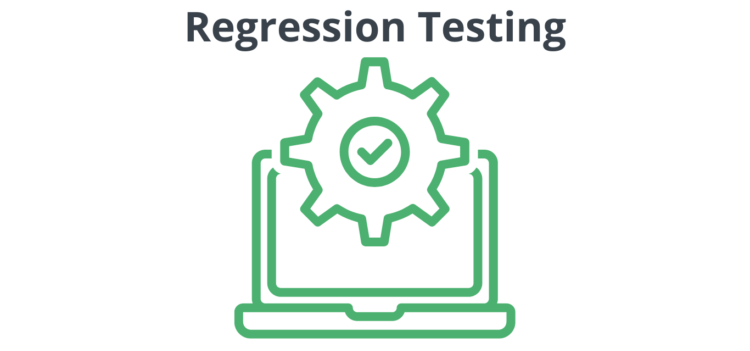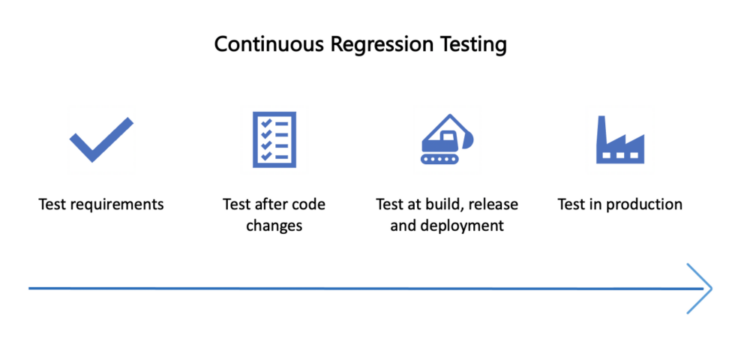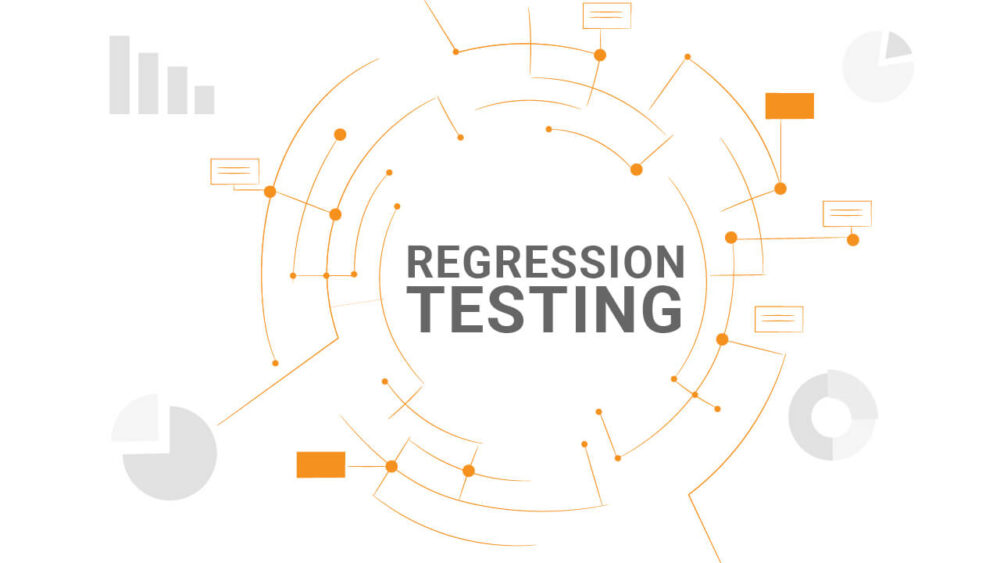The Role of Regression Testing in Continuous Testing and DevOps
Regression testing is an unavoidable aspect of software development that demands significant time and effort. Despite the investments made in creating and maintaining a regression test suite, issues often persist. The primary goal of regression testing is to reevaluate the application code whenever new release code is integrated into the main codebase to ensure its continued stability.
Continuous Testing is an integral element of DevOps, which is pivotal in enabling organizations to achieve rapid software delivery without compromising quality. DevOps represents a collaborative approach that amalgamates tools, processes, and cross-functional teams to streamline the deployment of applications and services. To ensure the seamless functioning of these applications and services, continuous testing is imperative.
In the DevOps paradigm, the concept of “continuous” is paramount, emphasizing the repetitive nature of actions. This article delves into the significance of continuous testing within DevOps and its role in assisting organizations in attaining their objectives. Through Automated Continuous Testing, coupled with a Shift Left approach, the gap between the conclusion of development and the initiation of testing can be effectively bridged.
What Is Regression Testing?

Source: qalified.com
Before delving into the answer, let’s examine the definition of regression testing.
Regression testing is a category of software testing that ensures that software, that has previously undergone development and testing, maintains its expected functionality even after undergoing alterations or integration with other software components. These modifications can encompass software enhancements, patches, configuration adjustments, and similar changes. (Source: Wikipedia)
While this definition provides a foundation, it doesn’t offer a comprehensive understanding of regression testing. Typically, regression testing is categorized into two primary types of tests:
- Tests that validate functional utilization and accurate data processing
- Tests that monitor and assess performance metrics.
Why Is Regression Testing Significant?
Whenever developers introduce alterations or improvements to code, they exercise great caution to prevent inadvertent disruptions or malfunctions in other aspects of the application. Despite the utmost care, issues can still arise; this is an inherent reality in the world of coding.
Acknowledging this, development teams conduct regression testing as a diligent process to verify and re-verify the various components of the application after the new code is released. This practice, in theory, confirms that the core functionality, performance, and interdependencies continue to operate correctly. Consequently, performing comprehensive regression testing on an application with every release before it goes live is imperative to prevent becoming the next cautionary headline.
What Is Continuous Regression Testing?

Source: cerberus-testing.com
Continuous regression testing extends the principles of continuous development and deployment into the realm of regression testing. Continuous deployment is a practice embraced by Agile and DevOps software development teams to enhance software quality by releasing code changes in smaller, more frequent increments.
The benefits of continuous deployment are numerous:
- Smaller code changes that are easier to pinpoint and troubleshoot.
- Speedier resolution of defects.
- Implementation of automated unit testing
- Accelerated release cycles.
- Enhanced customer satisfaction
- Reduction in overall costs.
Continuous regression testing essentially applies this continuous cycle to the domain of regression testing. It entails the continuous execution of regression tests throughout the software development process rather than confining them to planned testing cycles. Testing occurs during development and post-development and spans both pre-release and post-release phases. Regardless of the specific iteration or developmental stage, testing becomes an ongoing, continuous practice.
To seamlessly integrate Continuous Testing into Agile and DevOps workflows, organizations can leverage automation tools like LambdaTest.
Cloud-based AI-powered test orchestration and execution platforms like LambdaTest empowers users to create and execute automated regression tests at scale across 3000+ real browsers, devices, and OSes. Furthermore, it offers cross-device and cross-browser compatibility, guaranteeing the high quality of your software.
LambdaTest offers a robust AI-powered SmartUI platform for visual regression testing platform that is crucial in ensuring the visual integrity and consistency of your web applications and websites across various browsers, devices, and operating systems. Visual regression testing is a critical part of quality assurance, as it helps identify unintended visual changes that can occur when code is modified or when new features are added to a web application.
What is continuous testing in DevOps?

Continuous testing involves the automated execution of tests within the software delivery pipeline to promptly assess the outcomes and business risks associated with a potential software release.
Continuous testing serves as a strategy for expeditiously and reliably advancing software releases. Its core principle revolves around subjecting software to extensive testing throughout the development process until it’s ready for release. This approach accelerates feedback collection, ensures result accuracy, and reduces the effort spent on test maintenance while minimizing false positives.
Continuous testing entails activating tests initiated by the development environment or developers/testers, enabling a more rapid evaluation of requirements, spanning from user stories to system requirements.
Where Does Regression Testing Fit in the Software Development Lifecycle?
In both Agile and DevOps development environments, regression testing consistently follows the integration testing phase and precedes user testing and deployment to the production environment. This sequencing is quite straightforward, but the more significant question revolves around the responsible party for conducting regression testing.
Historically, dedicated testers have assumed this role, but depending on the organization’s structure, it may be delegated to a developer or even automated testing tools. There are even automated testing tools equipped with artificial intelligence capabilities designed for regression testing purposes. Nevertheless, the conventional approach typically entails regression testing being carried out by a test engineer who not only creates but also manages the test cases, ensuring the comprehensive evaluation of all modules in alignment with user-defined specifications.
It is essential to emphasize that regression testing holds equal importance to the development phase within the release process. Its primary objective is to guarantee the correct functionality of the application, thus preventing customers and business teams from encountering issues that could tarnish the organization’s reputation for the wrong reasons.
Efficient Regression Testing in a Continuous Delivery DevOps Environment

Source: launchdarkly.com
The testing stages, as depicted in the diagram above, remain consistent whether your organization follows the Agile or DevOps approach. The primary distinction between these approaches arguably lies in minor adjustments to the development lifecycle and allocating responsibilities across testing stages.
Under the Waterfall methodology, testing stages were well-defined and clearly delineated by distinct roles held by various individuals and teams. Developers were responsible for development, testers handled testing, and managers oversaw the process. However, the advent of Agile, with its continuous delivery and continuous testing model, has blurred the once well-defined boundaries. As organizations strive to enhance the efficiency of the development lifecycle, the responsibilities associated with each stage have shifted leftward.
In practice, this shift implies that developers have taken on a more substantial role in testing to expedite issue resolution and code release. Subsequently, the introduction of DevOps aimed to enhance efficiency further, causing the lines of distinct roles to blur even more. This resulted in a further leftward shift of responsibilities within the cycle. Developers assumed additional testing responsibilities, while testers increasingly engaged in development tasks.
In certain instances, tasks traditionally under the purview of operations are now undertaken by testers and developers. They interact directly with customers, identify issues, and swiftly resolve them.
This discussion concludes at this point, highlighting the comparison between these two methodologies. Nevertheless, despite these efficiency improvements and shortened timelines, the significance of testing stages remains unchanged and as vital as ever. To develop high-quality software quickly and efficiently, the key lies in providing efficient and effective regression testing.
Sustaining an Effective Test Plan
Just as enterprise application code undergoes constant evolution and improvement, the practice of effective regression testing must also evolve and adapt to keep pace with these changes. Regression test plans should not only reflect the latest modifications in application code but also progressively enhance their effectiveness, thoroughness, and efficiency. A Test Plan should be viewed as a dynamic and evolving document.
Regression Testing Tools and Solutions

Source: toptal.com
The realm of automated software testing offers a range of tools, each with its touted advantages. Depending on your organization’s application, interface, network, or methodology, there is likely a suitable automated testing solution available. For instance, if your requirement involves conducting regular regression tests on a web interface, Selenium, specializing in web browser automation, represents a viable solution worth considering.
Test Metrics
Plutora captures detailed information and outcomes from every test conducted across the enterprise. Robust reporting and analytics tools then collate and present real-time data in reports and dashboards, offering testers, stakeholders, and decision-makers insights into progress and results at any given moment. Additionally, Plutora has partnered with Tableau to provide customers with an exceptionally powerful analytics solution. This empowers users to delve deep into data, facilitating the identification of progress, coverage, risk areas, key performance indicators (KPIs), schedules, bottlenecks, and more.
Environment Management
To conduct accurate regression testing on new application code, it must be tested in an environment that closely replicates the production environment. In a global enterprise setting, this entails mimicking the behavior of thousands or even millions of customers, encompassing an intricate network of servers, applications, firmware versions, and more. The provisioning of such environments needs to be carried out repeatedly to cater to the diverse needs of various development teams.
What Are the Advantages of Implementing Continuous Testing in DevOps?
Continuous Testing holds a pivotal role within the DevOps framework, yielding several notable benefits that contribute to the overall quality of software.
Early Detection of Defects:
Continuous Testing excels in the early identification of software flaws during the developmental phases, enabling developers to address and rectify issues promptly.
Enhanced Software Quality:
By adhering to rigorous testing protocols, Continuous Testing guarantees that software meets stringent quality standards. Consequently, this reduces the incidence of problems and errors, ultimately enhancing the end-user experience.
Accelerated Time-to-Market:
Continuous Testing empowers organizations to expedite the release of new features and user updates. This ensures that any modifications or additions are deployed swiftly and seamlessly, minimizing delays and issues.
Increased Operational Efficiency:

Source: infoworld.com
Automating testing procedures by Continuous Testing liberates developers from time-consuming testing tasks, allowing them to concentrate on other critical activities. This enhanced efficiency promotes overall productivity.
Improved Collaboration:
Continuous Testing fosters collaboration among developers, testers, and operations teams. This collaborative approach encourages increased communication and the development of more effective software creation practices.
Cost Reduction:
Continuous Testing is a cost-effective strategy for software development. By identifying and addressing issues early in the development process, it prevents these problems from escalating into more complex and costly challenges. This translates to savings in terms of time and resources, as larger issues are less likely to arise.
Conclusion
Continuous Testing constitutes a pivotal element of DevOps, assuring the smooth functionality of your software. It facilitates early issue detection, expedites feedback gathering, and enhances overall efficiency, all while maintaining cost-effectiveness.



















